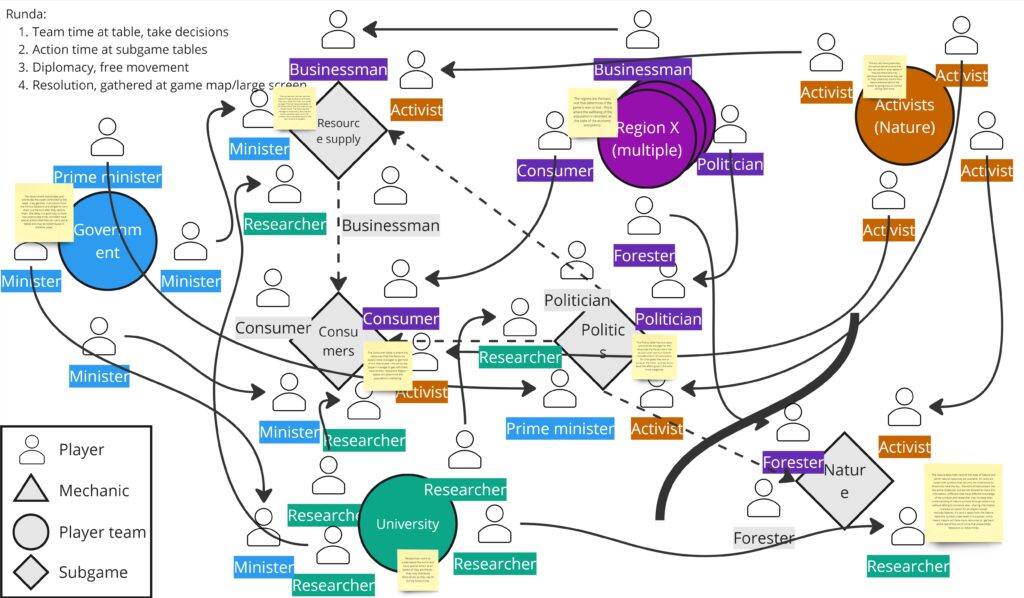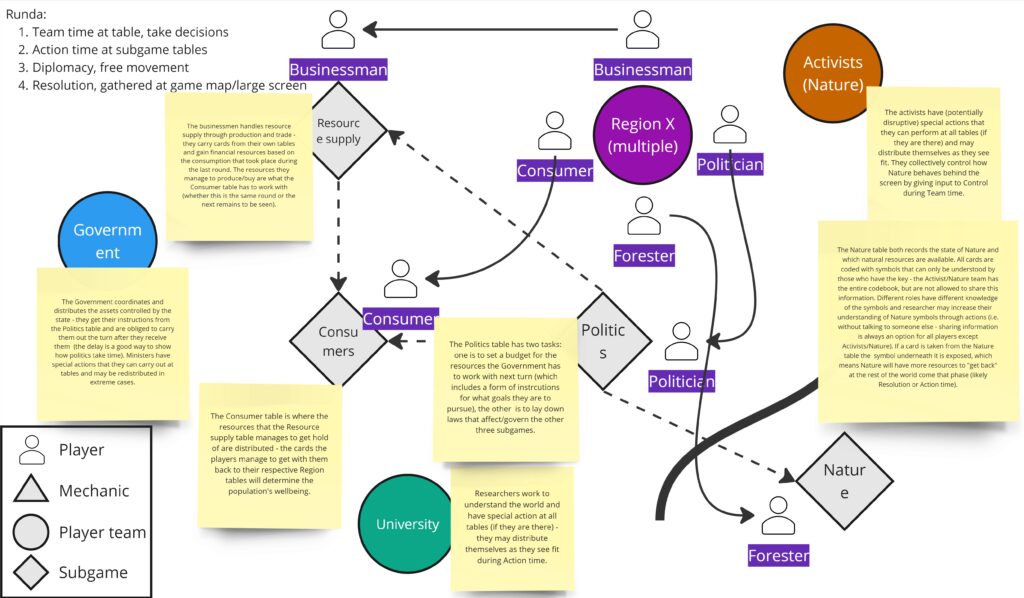After a very rewarding round of feedback from my colleagues in the project and a refreshing run of Watch the Skies by the East Sweden Megagames network, it was less of a challenge to put together a draft of what may become the skeleton of the Melting the Polarization (MtP) megagame. In this post, I’ll outline my thoughts and try to connect it to the feedback I got on my last post, in the hopes of contributing to the discussion of the game concept that will take place tomorrow.

What you see above is a (very confusing) concept drawing of a megagame, and in the following I’ll try to explain it a little bit. There are four types of tables, each with a different colour in the drawing above: one table each for the Government, Activists, and the University, and multiple Region tables (as many as are needed to accommodate the number of players, but likely no more than ten).
There are four players belonging to each table, which have different roles but form a team that play together and attempt to achieve certain goals; what these goals are vary between tables. The players begin the turn at their table by planning what each player should do during the Action phase, and then leave their table to go to other tables (called subgames above), where they perform actions to the best of their ability and also negotiate with other players, after which they return to their table to sum up the round’s activities.

In the illustration above, the places where the Region tables’ (there are several) go during the Action phase. The Businessman goes to the Resource supply table, carrying with them any cards (money, workforce, etc.) that they can use to produce and purchase resources (food, consumer goods, export goods, etc.) that the people in the country need to thrive. The Consumer goes to the Consumer table and try to purchase the things that come from the Resource supply table and which the region’s population need to survive and increase their wellbeing. The Politician goes to the Politics table, where they together with the politicians from other tables decide on a budget for the Government and make new laws that affect all other tables. The Forester goes to the Nature table, which is behind a screen, and manages the region’s natural resources (mostly forest and fields, but there are some mines to the north).

There are four subgames: Resource supply, Consumers, Politics, and Nature. Above, you can see which players are at the Nature and Politics tables during the Action phase – in essence, players from all tables are present at all tables (except for the Nature table, where there is no Government minister present), but in varying numbers; the Region players (Businessmen, Consumers, Politicians, and Foresters) are in majority at all tables. The Government, Activists, and University teams may decide to send multiple players to one table and none to others, depending on their assessment of what is required to reach their goals.
The Nature table is the most baffling to most players: it consists of a large map with cards (forest, grain, ore, etc) placed on top of it, and under each card there is one or more symbols, which mean very little to most of the players (researchers can research them, of course, but that takes time). The only ones that understand them all, but are not allowed to say so, are the activists – they are in fact playing Nature, secretly sending swarms of insects to destroy fields of grain and tearing through the monoculture forests based on which cards the Forester players take away from the Nature table to use in production and trade. The Nature team is posing as activists at the start of the game and their goal is to understand what is driving the humans to tear everything down in their search for happiness through the possession of more worldly possessions – much like the aliens in Watch the Skies are trying to understand and communicate with humans from behind their screen – but after a few turns they will be able to reveal their identity and negotiations between Nature and all other tables will be held openly. Interesting and a bit scary to negotiate with someone who can release a tornado or an Ice Age if you won’t agree to their terms, won’t you say?
In the game, players begin by facing the reality of trying to stay alive and thrive in their regions while negotiating the impact this has on the world around them. The scenario starts with a round of everything going according to plan, i.e. business gets their supply of the things people need, consumers gets what they require (and a little extra to make them happy), and politics establish a plan forward. On round two, a shortage of energy (likely oil, but could be something else) will impact the country, sending players far and wide in search of a new means of supporting their system – and they will likely end up trying to make up for it by taking cards from the Nature table, to which Nature will reply harshly. After this, the Nature team will step forward, and there will be a couple of rounds where humans and Nature try to work things out, and the game ends in whatever crisis will be the result of their efforts – it’s very unlikely that they will find a plausible way that suits everyone right off the bat, but there some progress wil likely be made and some people may have to change their roles to accommodate the new world order.
The idea here is for players to journey from their reality to an awareness of nature as a partner that we need to take seriously when negotiating what our future should look like and in so doing begin to see the world around us as a whole, not only the parts not behind the screen. The choice of issues that players will face (the scenario) can change, but the energy one is perhaps most pressing – around 80% of all energy used in Sweden today is fossil, and although most people are all for replacing it, the issue of what to replace it with and what the world will look like once we have is a huge challenge that it may be argued we haven’t even begun addressing seriously yet.
